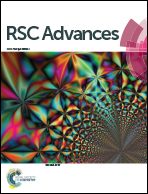Crystal phase content-dependent functionality of dual phase SnO2–WO3 nanocomposite films via cosputtering crystal growth†
Abstract
In this study, crystalline SnO2–WO3 nanocomposite thin films were grown through radio-frequency cosputtering of metallic Sn and ceramic WO3 targets. The W content in the SnO2 matrix was varied from 5.4 at% to 12.3 at% by changing the WO3 sputtering power during thin-film growth. Structural analyses showed that increased WO3 phase content in the nanocomposite films reduced the degree of crystallization of the SnO2 matrix. Moreover, the size of the composite films' surface crystallites increased with WO3 phase content, and the large surface crystallites were composed of numerous nanograins. Addition of WO3 crystals to the SnO2 matrix to form a composite film improved its light harvesting ability. The SnO2–WO3 nanocomposite films exhibited improved photodegradation ability for Rhodamine B dyes compared with their individual constituents (i.e., SnO2 and WO3 thin films), which is attributable to the suitable type II band alignment between the SnO2 and WO3. Moreover, an optimal WO3 phase content (W content: 5.4 at%) in the SnO2 matrix substantially enhanced the ethanol gas-sensing response of the SnO2 thin film. This suggested that the heterojunctions at the SnO2/WO3 interface regions in the nanocomposite film considerably affected its ethanol gas-sensing behavior.



 Please wait while we load your content...
Please wait while we load your content...